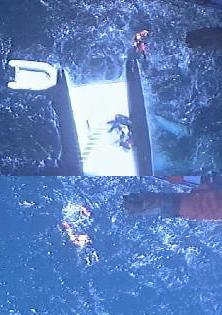|
|||||||||||
|
|
|
|||
|
By |
||||
 |
July 6, 2010 -
Coast Guard units from Group Humboldt Bay rescued three sailors who were
not wearing life vest from an overturned sailboat 20 miles off the coast
of
At 12:44 p.m., the
Coast Guard received an emergency position indicating radio beacon
signal from the Cataylist. The beacon, mounted on the sailboat, can be
turned on in an emergency to transmit the GPS position, identity of the
vessel and other information to a network of satellites orbiting the
earth. The EPIRB showed the
Cataylist was approximately 20 miles from the coast of
The Cataylist?s
crew reported that in the early morning hours, winds increased to 45
knots and the crew manually activated their EPRIB, believing that their
lives were in peril.
Immediately after activating the radio beacon, the boat capsized,
pinning the crew beneath its overturned hull.
The crew managed to get out from beneath the vessel and grab onto
the hull, spending more than an hour in the frigid |
|||
|
|
||||
|
The Coast Guard
used the registration information from the beacon to contact the family
of the vessel?s crew. The family reported the Cataylist crew had left a
float plan, which is a description of the boat, number of passengers
aboard, a description of the safety equipment aboard, destination and
estimated time of arrival.
Coast Guard Group
Humboldt Bay immediately dispatched a 47-foot motor lifeboat from |
||||
|
The helicopter arrived on scene first and started following the radio beacon signal from the catamaran?s EPIRB. The helicopter located the overturned boat, its hull blending in with the white-capped waves, and descended to a hover over the vessel where the crew spotted three people clinging to the hull as waves washed over the boat. ?Another key to finding this crew was that they stayed with their vessel. It is much easier to find a boat, even an overturned boat, in the ocean than an individual person,? said Lt.j.g. Bernie Garrigan, the Dolphin helicopter co-pilot.
With the 47-foot
motor lifeboat eight minutes away, the helicopter crew decided to lower
it's rescue swimmer, Petty Officer 2nd Class David Foreman, an emergency
medical technician, down to the crew of the overturned Cataylist to
assess their condition. Foreman entered the water and swam to the
catamaran where he noticed that all three sailors were showing signs of
hypothermia. He then requested that the helicopter hoist the three
survivors into the aircraft for transport to a hospital.
The helicopter
hoisted all three sailors and decided to let the motor lifeboat crew
pick up the rescue swimmer. With the rescue swimmer safely aboard the
motor lifeboat, the helicopter flew to The Coast Guard reminds mariners that the maritime environment is extremely dangerous and this case serves as a reminder to wear your life jackets at all times and equip your vessel with the the latest safety gear, including a VHF radio, flares and an emergency radio beacon. Mariners are recommended to file float plans with loved ones or friends ashore, so someone may provide information about the vessel and their intended voyage timeline to the Coast Guard during emergencies. ?If you ever wanted to hear a story about how important it is to have a registered EPIRB on your vessel and a float plan ashore, look no further than this case. Without that piece of electronic gear aboard the Cataylist, this would be the story of a maritime disaster, not a story with a happy ending,? said Lt. Todd Vorenkamp, a Coast Guard spokesperson. ?That EPIRB saved their lives,? said Suchanek. |
|
|
| Other News Stories |
| ?AvStop
Online Magazine
Contact
Us
Return To News
|
|


